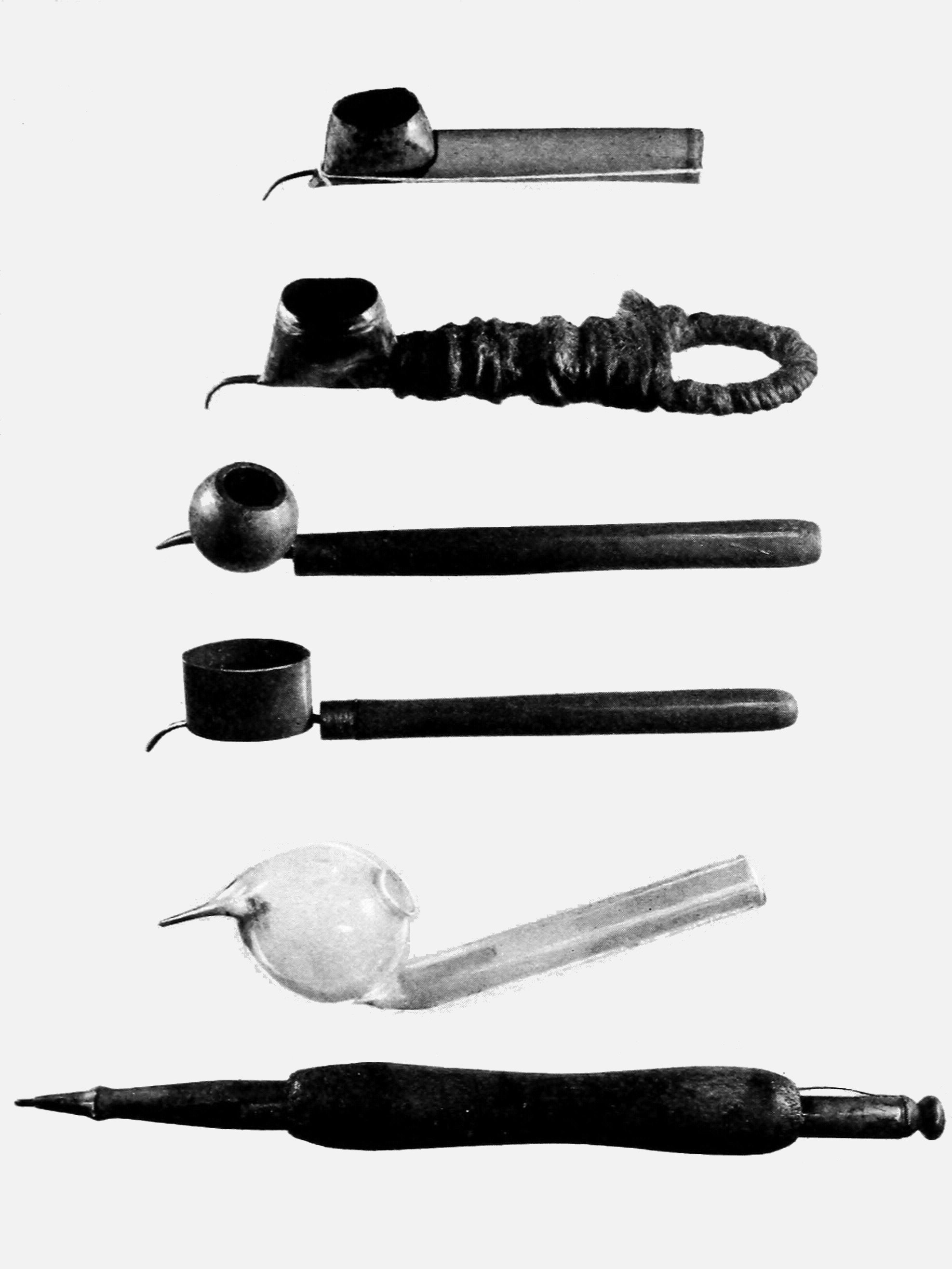TJANTINGS
Ever since the batik art has been practised by occidentals there has been a search for a tool to replace the tjanting, or perhaps not so much to replace, as to develop an improved edition. But after many trials, it seems that the tjanting in its original form, with just a slight variation in its handle, is after all, the best instrument for fine line and dot work.
The Dutch edition of the original Javanese tjantings is better than the native tool in two particulars. First, it is made out of heavier metal and is consequently much stronger and the second distinct improvement is the re-modelled handle which replaces the little tied-on bamboo affair. Of course when the difference in price is taken into consideration the Javanese tjanting stands away above any other,—it costs from 1 to 10 cents in Dutch money, which is the equivalent of five tjantings for two cents, American money, whilst the Dutch-model tjanting made here in New York, is sold for from $5.00 to $7.00 apiece.
Various kinds of tjantings are shown in the accompanying illustrations. 1. The original Javanese tjanting. 2. The Dutch tjanting. 3 and 4. Belgian tjantings. 5. The Walther glass tjanting. 6. The wax pencil. The first two of these types have already been described.
3. A Belgian tjanting. This tool has a few very good points, but the trouble is, that whilst each factor in itself is good, the combination of them in the tjanting is not desirable. The cup of this instrument is made out of a brass ball out of which a segment is taken to form the top opening; on one side, not quite at the lowest point of the ball, the spout is placed, while the handle is fastened opposite to it on the other side. This placing of the spout has one great advantage as any impurity in the wax will settle below the spout opening, and clogging is less liable. The spout is made of solid brass plate; it is tapered and the nozzle has a fine opening. The only disadvantage to it is, that it cannot be shaped, that is, it cannot be bent up or down at the will of the worker.
The main objection to this tool is, however, that it is rather heavy by reason of its very solid cup and it does not balance well in the hand.
Besides the before-mentioned advantage of the spout being unlikely to clog, the greatest thing in its favour is, the long time that it holds the wax hot; on account of its round shape, the small opening on top, and above all, because of the thickness of the walls of the cup, the wax retains the heat longer than in any other tjanting made.
4. A second type of Belgian tjanting. This tool very much resembles some of the first tjantings made in this country. It is not very good, mainly on account of the spout, which is not tapered, and another weak point is the cup, which holds only a very little wax.

5. The Walther glass tjanting. This is a German invention and is certainly no improvement on any existing type of instrument. In fact it is a clumsy and awkward tool, difficult to handle, and being made of glass it is of course, very fragile.
6. The wax pencil. This is another German attempt to replace the tjanting and is made in two separate parts. First, the metal cylinder which holds the wax and replaces the cup and spout of the tjanting and the second part is the wooden holder, which slips over the cylinder and serves as a handle. The cylinder itself is of brass, shaped to a point at one end and at the other is closed with a brass stopper. The pointed end is fitted with a fine needle which is held in place by a minute spiral spring. This needle closes up the opening in the tube and prevents the molten wax from flowing out. When a flow of wax is desired, the pressure of the point of the “pencil” on the fabric, will push back the needle and release the wax.
To fill the tool, the wax is scraped into fine chips, or better still, cut into a thin bar, and inserted in the tube and closed in with the stopper. The wooden handle is then slipped back and the tool heated in a flame to melt the wax; when the instrument is sufficiently hot, the handle is slipped back in position, and work can be started.
A great drawback to this tool is that it gets very hot, so hot in fact, that the wooden handle is likely to char, as is shown in the one illustrated, and after working some time one has to stop in order to give the handle a chance to cool.
Very fine work cannot be done with this instrument and the opinions as to its usefulness are very divided. Some people say the tool is as good as useless, whilst others cannot or will not work with anything else—this is most probably because they never had a good tjanting, if they had they would soon put their wax-pencils in the discard.
The main thing in favour of the tool is, that it makes very little wax smoke in the room, but this is its only virtue and it does not have a monopoly of that, as any batiker, with a little care can keep his or her wax as hot as it is needed without having a column of smoke constantly coming out of the wax pot.
Although much time has been spent and trouble been taken in endeavours to supply a tool which would be better and more practical than the tjanting, it can be safely said that the original appliance has stood up successfully against all competitors and nothing better has yet been made.